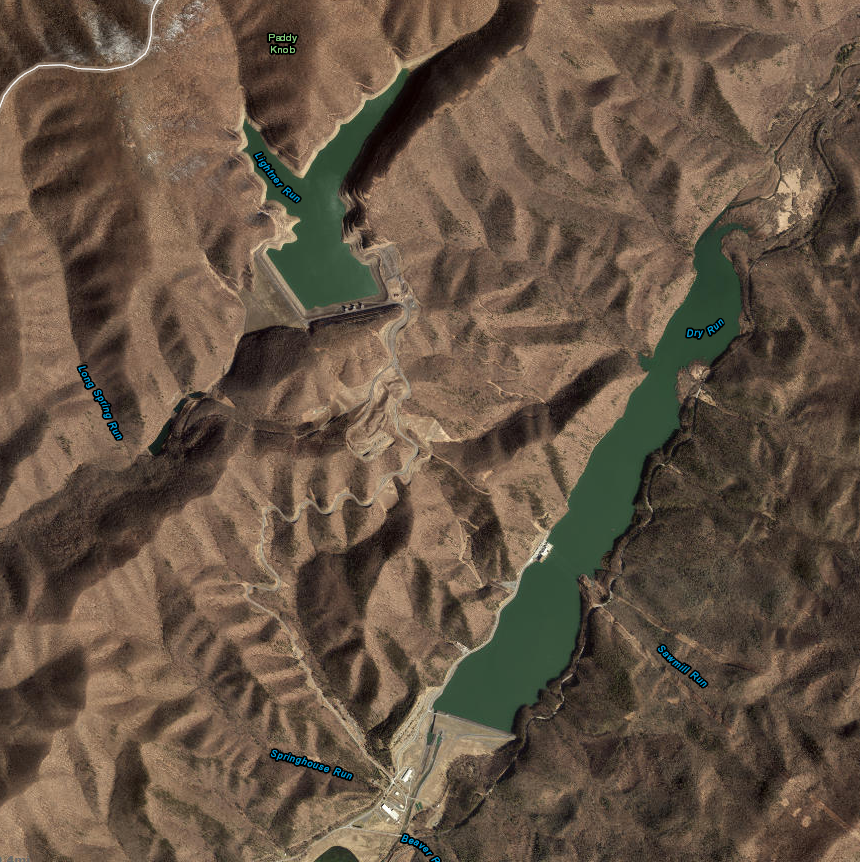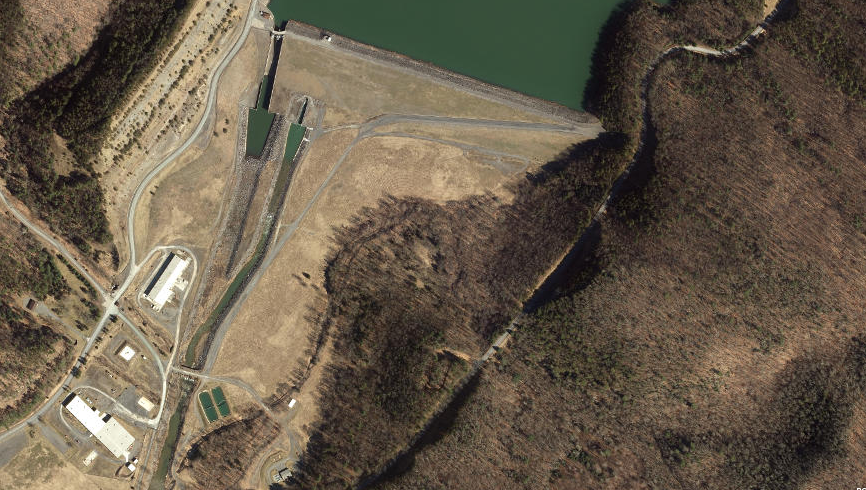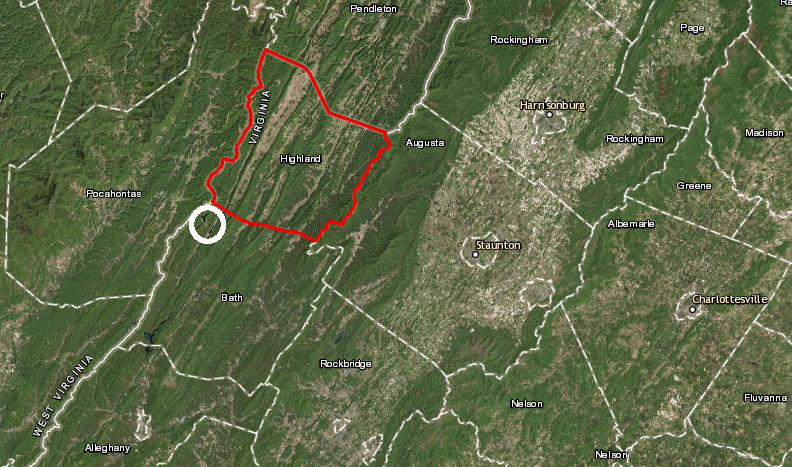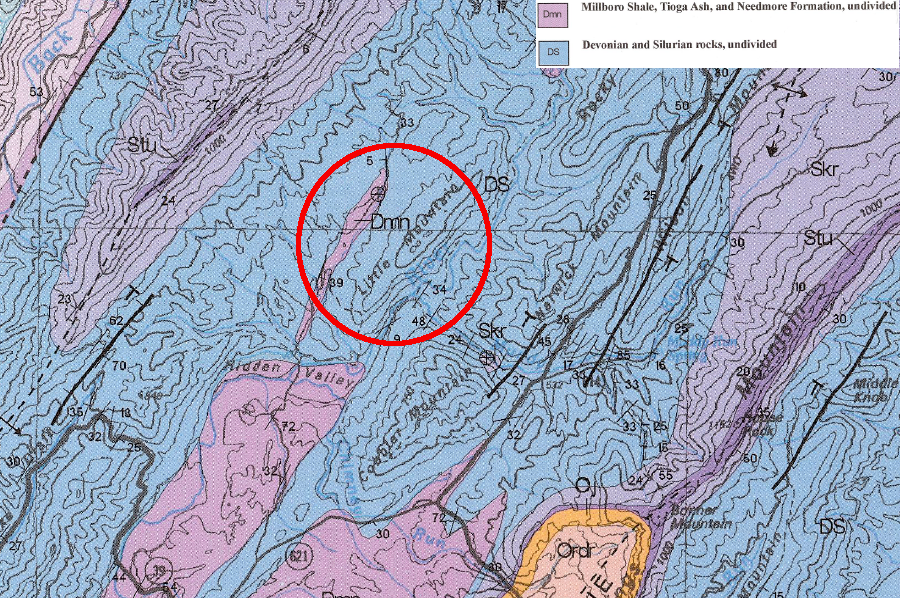
at the Bath County Pumped Storage Station, Dominion Energy pumps water between two reservoirs to create a giant battery providing electricity at times of peak demand
Source: ESRI, ArcGIS Online

at the Bath County Pumped Storage Station, Dominion Energy pumps water between two reservoirs to create a giant battery providing electricity at times of peak demand
Source: ESRI, ArcGIS Online
In 1971, the Virginia Electric and Power Company (VEPCO), now known as Dominion Energy, obtained preliminary permits from the Federal Power Commission for two pumped storage projects. One would have used Goose Creek and Bottom Creek near Roanoke, while the other used Little Back Creek and Back Creek in Bath County north of Covington.
At the time, the utility company was committed to a major expansion of its baseload generation capacity. Between 1972-1980 it started construction of nuclear reactors, two at Surry and two at North Anna. Even with the additional 3,500MW (megawatts) from those four reactors, VEPCO calculated that it would need additional capacity during peak demand periods (typically 11:00am-8:00pm), but would have surplus capacity during nighttime.
VEPCO calculated that one pumped storage facility generating 2,100MW was the cost-effective way to meet peak demand. Appalachian Power had proposed building a pumped storage project on the Roanoke River in the 1920's. It finally started building the Smith Mountain and Leesville dams in 1960, and completed them three years later. From VEPCO's perspective in 1971, pumped storage was already a proven technology with a track record of meeting electricity peak demand requirements in Virginia.
VEPCO had alternatives. It could ask for State Corporation Commission approval to build another coal-fired power plant or nuclear reactor, but the additional electricity would be unneeded for much of the day. The priority was to create greater flexibility in generating electricity at hours of peak demand, rather than overall greater capacity.
The utility could have proposed to build a power plant fueled by natural gas, since such facilities could be turned on and off relatively quickly. In the 1970's, the limited availability and high price of natural gas made that option unattractive.
At the time, the Federal government still regulated the price of natural gas. There were few economic advantages to explore for natural gas, particularly in unconventional locations. In 1971, VEPCO did not anticipate the fracking boom that would generate a surplus of gas three decades later, ultimately causing a dramatic reduction in the price of that fuel.
Other alternatives examined included solar, wind, fusion, and fly-wheel energy storage. They were labelled as "exotic" and not considered to be viable alternatives, reflecting the technological capabilities and economics of the time. (Since 1971, battery technology had advanced. Alternatives today include redox flow, iron-air, sodium-ion, solid-state, lithium-sulphur, and calcium-ion. There are also hermal and gravity storage systems.)
Small coal-fired power plants designed for quick start-up and gas-fired plants were realistic choices in 1971, as was a change in the rate structure to incentivize customers to reduce use of electricity at times of peak demand.
A conventional hydroelectric plant was also considered. A location to build a new dam and reservoir would be difficult to find, but a small project might be feasible. It could release water to operate turbines during just that part of the day when extra power was needed. However, the storage capacity behind such a dam was identified as too low, while costs to operate a small conventional hydropower facility were projected to be higher than at a large pumped storage project.1
VEPCO identified a pumped storage facility as its preferred option, and chose the Bath County site as its preferred location. The utility allowed the Federal Power Commission permit involving Goose Creek and Bottom Creek to expire in 1975.

VEPCO dropped its plans for a pumped storage project involving Goose Creek and Bottom Creek 15 miles southwest of Roanoke, and built in Bath County instead
Source: ESRI, ArcGIS Online
Construction of the Bath County Pumped Storage Station started in 1977, but stopped three years later because the growth in peak demand for electricity had not grown as projected by VEPCO. The utility then sold Allegheny Energy a 40% share and completed construction. Allegheny Energy was a separate utility than Appalachian Power, and at the time its Potomac Edison Company subsidiary sold electricity in Virginia.
Allegheny Power had proposed to build its own pumped storage project in West Virginia. The lower reservoir would have flooded Canaan Valley, whose wetlands and upland habitats were being considered for permanent protection as a National Wildlife Refuge. The Federal Energy Regulatory Committee approved the pumped storage project, but the U.S. Army Corps of Engineers denied the Clean Water Act Section 404 permit needed for construction.
Rather than wait for the lawsuits to be resolved for its Canaan Valley project, Allegheny Power proceeded to purchase a 40% share of the Bath County project. In 1988, the Supreme Court ruled that the Corps' denial of the Section 404 permit would stand, and Canaan Valley would not be flooded for a reservoir. Allegheny Power sold its 12,000 acres in Canaan Valley to the US Fish and Wildlife Service in 2002.2
Neither of the two investor-owned utilities needed the full capacity to generate peak power from the facility, but sharing the power and sharing the costs made it feasible. The Bath County Pumped Storage Station was completed and started generating electricity in 1985.
Today, it can generate 3,003MW (megawatts) when all six generators are operating at full power. National Public Radio titled a story on the project "The World's Biggest Battery," and within the United States only Grand Coulee Dam has more capacity to generate electricity. Dominion Energy has referred to its Bath County facility as a "mountain of power" and "a quiet giant," and claims it is:3
There are nearly 300 pumped storage projects in the world, and 40 in the United States. While the facility in Bath County is the largest now, a 4,000MW project at Lake Revelstoke in British Columbia has been proposed. In 2017 the largest pumped storage in Europe was the Cortes-La Muela hydroelectric project in Spain, rated at 1,762MW. The largest in China was the Cuntangkou Pumped Hydro Power Station in Sichuan, rated at 2,000MW.4
The Snowy Hydro 2.0 pumped storage project in Australia completed a feasibility study in 2017 that proposed to expand the existing network of hydropower dams to provide up to 6,000MW of generating capacity. It would become the world's largest hydropower scheme with pumped storage. The company claimed that the proposed Snowy Hydro expansion would have:5
To generate electricity at the Bath Pumped Storage Project in Virginia, water is released from the upper reservoir created by damming Little Back Creek. The water flows down through turbines into the lower reservoir, which was created by buildig a dam across Back Creek.
The water level in the upper reservoir can drop 105 feet, and in the lower reservoir can rise 60 feet. The dam on Little Back Creek, creating the upper reservoir, is 460 feet high. The dam on Back Creek, creating the lower reservoir, is 135 feet high.
The dams must be kept clear of trees. If a storm blew down a tree, an uprooted rootball could displace enough earth to weaken the structure. The dam for the lower reservoir is to steep for mowing the grass, so Dominion Power rents a herd of 30 goats and an accompanying guard dog each summer.6

a dam 460 feet high blocks Little Back Creek and creates the upper reservoir
Source: ESRI, ArcGIS Online
The water flows drops 1,262 feet from the upper to the lower reservoir. It moves through three tunnels or "penstocks" carved through Little Mountain, which separates Little Back Creek and Back Creek. The penstocks are 3,780 feet long and 28.5 feet in diameter, and have concrete walls 18-24 inches thick.

penstocks cutting though Little Mountain include both horizontal and vertical sections
Source: Virginia Electric and Power Company, Bath County project: Draft Environmental Impact Statement (p.1-24)
There are two turbines at the bottom end of each penstock. They are reversible, and serve as pumps as well as electricity generators. The six turbines were upgraded between 2004-2009, increasing output by slightly less than 10%. The new turbines were manufactured with tolerances smaller than the width of a sheet of paper.

penstocks through Little Mountain (brown lines) carry water down to the lower reservoir, then back up to the upper reservoir
Source: US Geological Survey (USGS), National Map
The maximum power generation of 3,030MW is possible only when the reservoir is full. As the upper reservoir drains, the elevation of the water drops and the turbines spin at slower speeds.
The water flow is timed to provide electricity when demand peaks, typically in the summer when air conditioners kick on between lunch and early evening. At times of low demand, such as the middle of the night, flow is reversed. Baseload power plants provide the electricity to pump water back into the upper reservoir. The price of a kilowatt-hour of electricity sold in the late afternoon is high. The cost of a kilowatt-hour used to pump water uphill before dawn, when baseload plants can produce more electricity than customers are buying, is low.

stored water can be used to generate electricity when it is most valuable, and increase grid reliability by generating almost immediately if another power plant trips offline
Source: US Energy Information Administration, Pumped storage provides grid reliability even with net generation loss
Water flow when generating is 13.5 million gallons per minute. The flow when pumping uphill is slightly lower, at 12.7 million gallons per minute.
During the summer, there may not be enough time to pump all the water back uphill before electricity demand rises again and the flow must be downhill to generate power. Plant operators normally catch up and refill the upper reservoir on weekends. When full, the upper reservoir can has the capacity to provide 24,000 megawatt-hours of electricity. A major drought, restricting the ability to recharge the reservoirs with rainfall to offset evaporation and water released to maintain the fishery in Back Creek, could reduce that capacity.

the lower dam, blocking Back Creek, is 460 feet high
Source: ESRI, ArcGIS Online
The Bath County Pumped Storage Station uses more electricity than it generates; it is a net consumer, rather than producer of power. Pumping water uphill requires more electricity than the six turbines can generate. The plant is 80% efficient; for every four kilowatts of electricity generated, five kilowatts are consumed.
If the demand for electricity was steady throughout the day, without peaks of high demand and valleys of low demand during each 24-hour cycle, there would be no reason to build a pumped storage facility. The advantage of the facility is that it serves as a battery which can be turned on quickly as demand shifts, 4,500 times per year. If the upper reservoir was fully drained over 11 hours, it could produce 24,000 megawatt-hours of electricity.
The 500MW turbines can start exporting significant amounts of electricity into the grid within five-ten minutes. Unlike a coal-fired or nuclear generating plant, there are no significant delays for "warming up" and no downtime for refueling.7
Peak power can be generated for only three hours. Once the upper reservoir has emptied, the turbines need to be reversed to pump water uphill and "recharge the battery."8
The Bath County Pumped Storage Station does not use fossil fuels to produce electricity, so it does not add greenhouse gases to the atmosphere. If the electricity used to pump the water back up to the upper reservoir came from solar, wind, or nuclear power plants, then the pumped storage plant could be viewed as part of a power generation system that did not produce carbon dioxide (CO2) emissions.

the six turbines are located in the powerhouse where three penstocks reach the lower reservoir
Source: US Geological Survey (USGS), Sunrise, VA-WV 7.5 minute quadrangle map (2016)
Shifts in water levels within the upper and lower reservoirs are based on the demand for generating power, but the reservoirs could be used for flood control. The initial design included space for 2,500 acre feet. Capturing that much runoff could reduce the peak flow on Back Creek from 10,000 cubic feet per second (cfs) to 7,500 cfs.
Because water levels in the two reservoirs change so much and so rapidly, they are not safe for recreational use. To mitigate the impact of flooding 950 acres and five miles of Little Back Creek and Back Creek, Dominion Energy included built two recreational ponds and a campground.9

two recreational ponds and a campground were constructed as mitigation for flooding 950 acres and five miles of Little Back Creek and Back Creek
Source: ESRI, ArcGIS Online
The recreational ponds offer warmwater fishing opportunities for largemouth bass, sunfish, and channel catfish.
The water released from the lower reservoir into Back Creek is always cool, and offers a different fishery. The Virginia Department of Game and Inland Fisheries stocks trout in Back Creek below the lower reservoir's dam. The state agency has classified Back Creek between the dam and Route 600 as "Delayed Harvest Waters," requiring anglers to release whatever trout they catch and allowing use of just artificial lures (no bait) between October 1-May 31.10
Though the two reservoirs eliminated five miles of natural stream habitat, they also improved the local fishery. They provide a steady flow of water except in extreme droughts. When the reservoirs are at full conservation storage levels, stockpiling 3,200 acrefeet, they release a minimum of 15 cubic feet per second (cfs).
Counting seepage from the dam of the upper reservoir, Little Back Creek should receive a minimum of 2cfs. Back Creek should receive a minimum of 10cfs. If conservation storage drops to 50% or lower, the required minimum flows are reduced.11

two recreational ponds offer warmwater fishing, and 1.5 miles of Back Creek (between red asterisks) is designated as "Delayed Harvest Waters" for trout
Source: ESRI, ArcGIS Online
Constructing the pumped storage facility in rural Bath County created socioeconomic as well as environmental impacts. Many of the construction workers were expected to live in Highland County, which would receive no increased property tax revenues because the project was located south of the county boundary in Bath County. as a condition of awarding the license for the project, the Federal Energy Regulatory Commission required VEPCO to compensate Highland County:12

increased property tax revenues from the project benefit Bath County, while Highland County experienced extra costs during the 1977-85 construction
Source: ESRI, ArcGIS Online
Seven miles downstream from the pumped storage project, Little Back Creek flows into Back Creek. Another seven miles later, Back Creek flows into the reservoir created by Gathright Dam, which is named Lake Moomaw. Construction of Gathright Dam was complicated by the karst geology, and extensive grouting was required to seal leaks in the limestone bedrock.
The bedrock in the valley of Little Back Creek, in which the upper reservoir of the Bath County Pumped Storage Station was constructed, is shale. The bedrock in the valley of Back Creek, in which the lower reservoir was constructed, is limestone. Little Mountain, through which the penstocks were excavated, is also limestone.
When one of the penstocks carved through Little Mountain was first filled with water, there was enough leakage and pressure changes through the limestone to buckle a steel liner in an empty, adjacent penstock. As at Gathright Dam, grouting was injected into the bedrock to seal it.13

most of the pumped storage project was built in limestone bedrock
Source: Virginia Division of Mineral Resources, Geologic map of the Virginia portion of the Staunton 30 X 60 minute quadrangle (Publication 163)
Dominion Energy has retained majority control with 60% ownership of the pumped storage asset, but its minority partners have changed over time. Allegheny Energy sold its service areas to Shenandoah Valley Electric Cooperative and Rappahannock Electric Cooperative in 2010, but retained its ownership in the Bath County facility. Allegheny merged with FirstEnergy in 2011. In 2018, First Energy sold a portion of its ownership in the pumped storage project to LS Power, while a subsidiary still retained another percentage.
In 2021, LS Power owned a 23.75% interest (716 MW), and Allegheny Generating owned a 16.25% interest. Electricity was marketed through the PJM grid. One potential customer was Appalachian Power, which in 2021 was seeking suppliers to provide electricity from renewable resources.14

the water that flows into the two reservoirs of the Bath County Pumped Storage Station ultimately flows down the James River to the Chesapeake Bay
Source: US Geological Survey (USGS), Streamer

the Bath County Pumped Storage Station
Source: Virginia Electric and Power Company, Bath County project: Draft Environmental Impact Statement (Figure 1-4)